Spoilt for Choice: User-Centric Choice of Battery Size and Chemistry for Battery-Electric Long-Haul Trucks
Abstract
:1. Introduction
1.1. Contributions
- Comprehensive analysis of the feasibility of varying battery capacities for different use casesThis paper presents the first comprehensive analysis of which battery size is feasible for a long-haul BETs considering charging power, payload, and cell-individual vehicle restrictions as well as degradation effects.
- Novel investigation on the cost-effectiveness of oversizing the batteryWe analyze the trade-off between rising investment costs and less need to replace the battery during lifetime, caused by the degradation of the cell. We model the aging effects based on cell chemistry as well as available charging power and transported payload.
- Detailed analysis of the cost-optimal and use case individual choice of cell chemistryWe provide an in-depth comparison of the two mentioned cell chemistries, regarding cost-effectiveness. We significantly enhance the state of the art, considering detailed aging modeling and the dependency on available charging infrastructure. We additionally conduct a sensitivity analysis in order to make the influence of our assumptions as transparent as possible.
1.2. Organization of the Article
2. Method
2.1. Scenario and Power Profile
2.2. Electro-Thermal Aging Model
2.3. Cost Model
3. Results
3.1. Feasibility
3.2. Cost-Effective Battery Size
3.3. Cell Chemistry Comparison
4. Discussion
5. Conclusions
Author Contributions
Funding
Data Availability Statement
Conflicts of Interest
References
- European Commission; Directorate-General for Mobility and Transport. EU Transport in Figures: Statistical Pocketbook 2022; Publications Office of the European Union: Luxembourg, 2022. [Google Scholar] [CrossRef]
- Statistisches Bundesamt Deutschland. Road Transport: EU-Wide Carbon Dioxide Emissions Have Increased by 24% since 1990; Statistisches Bundesamt: Wiesbaden, Germany, 2023. [Google Scholar]
- European Commission; Directorate-General for Climate Action. Going Climate-Neutral by 2050: A Strategic Long-Term Vision for a Prosperous, Modern, Competitive and Climate-Neutral EU Economy; Publications Office: Luxembourg, 2019. [Google Scholar] [CrossRef]
- European Union. Verordnung (EU) 2019/1242 des Europäischen Parlaments und des Rates. Off. J. Eur. Union 2019, L 198, 202. [Google Scholar]
- European Commission. European Green Deal: Commission Proposes 2030 Zero-Emissions Target for New City Buses and 90% Emissions Reductions for New Trucks by 2040. Available online: https://ec.europa.eu/commission/presscorner/detail/en/ip_23_762 (accessed on 24 December 2023).
- Mulholland, E.; Rodríguez, F. Recommendations for Revising the Modalities of Europe’s Heavy-Duty Vehicle CO2 Standards; International Council on Clean Transportation: Washington, DC, USA, 2022. [Google Scholar]
- MAN Truck and Bus, SE. NEFTON: MAN Conducts Research in Joint Project for Battery-Electric Freight Transport of the Future; MAN Truck & Bus: Munich, Germany, 2022. [Google Scholar]
- Breed, A.K.; Speth, D.; Plötz, P. CO2 fleet regulation and the future market diffusion of zero-emission trucks in Europe. Energy Policy 2021, 159, 112640. [Google Scholar] [CrossRef]
- Speth, D.; Funke, S.Á. Comparing Options to Electrify Heavy-Duty Vehicles: Findings of German Pilot Projects. World Electr. Veh. J. 2021, 12, 67. [Google Scholar] [CrossRef]
- Basma, H. Total Cost of Ownership for Tractor-Trailers in Europe: Battery Electric Versus Diesel; International Council on Clean Transportation: Washington, DC, USA, 2021. [Google Scholar]
- Plötz, P. Hydrogen technology is unlikely to play a major role in sustainable road transport. Nat. Electron. 2022, 5, 8–10. [Google Scholar] [CrossRef]
- Wolff, S.; Seidenfus, M.; Brönner, M.; Lienkamp, M. Multi-disciplinary design optimization of life cycle eco-efficiency for heavy-duty vehicles using a genetic algorithm. J. Clean. Prod. 2021, 318, 128505. [Google Scholar] [CrossRef]
- Noll, B.; Del Val, S.; Schmidt, T.S.; Steffen, B. Analyzing the competitiveness of low-carbon drive-technologies in road-freight: A total cost of ownership analysis in Europe. Appl. Energy 2022, 306, 118079. [Google Scholar] [CrossRef]
- Wolff, S.; Schneider, J.; Balke, G.; Zähringer, M.; Büttner, S.; Schuckert, M.; Jaensch, M. Battery, Hybrid Electric Vehicles—Trucks and Busses—And I would drive 500 miles—With batteries? Encycl. Electrochem. Power Sources, 2023; under review. [Google Scholar]
- Teichert, O.; Link, S.; Schneider, J.; Wolff, S.; Lienkamp, M. Techno-economic cell selection for battery-electric long-haul trucks. eTransportation 2023, 16, 100225. [Google Scholar] [CrossRef]
- Bundesministerium der Justiz. Straßenverkehrs-Zulassungs-Ordung. 2002. Available online: https://www.gesetze-im-internet.de/stvzo_2012/BJNR067910012.html (accessed on 24 December 2023).
- Nykvist, B.; Olsson, O. The feasibility of heavy battery electric trucks. Joule 2021, 5, 901–913. [Google Scholar] [CrossRef]
- Mareev, I.; Becker, J.; Sauer, D. Battery Dimensioning and Life Cycle Costs Analysis for a Heavy-Duty Truck Considering the Requirements of Long-Haul Transportation. Energies 2018, 11, 55. [Google Scholar] [CrossRef]
- Schneider, J.; Teichert, O.; Zähringer, M.; Balke, G.; Lienkamp, M. The novel Megawatt Charging System standard: Impact on battery size and cell requirements for battery-electric long-haul trucks. eTransportation 2023, 17, 100253. [Google Scholar] [CrossRef]
- Babin, A.; Rizoug, N.; Mesbahi, T.; Boscher, D.; Hamdoun, Z.; Larouci, C. Total Cost of Ownership Improvement of Commercial Electric Vehicles Using Battery Sizing and Intelligent Charge Method. IEEE Trans. Ind. Appl. 2018, 54, 1691–1700. [Google Scholar] [CrossRef]
- Karlsson, J.; Grauers, A. Case Study of Cost-Effective Electrification of Long-Distance Line-Haul Trucks. Energies 2023, 16, 2793. [Google Scholar] [CrossRef]
- Al-Saadi, M.; Olmos, J.; Saez-de Ibarra, A.; van Mierlo, J.; Berecibar, M. Fast Charging Impact on the Lithium-Ion Batteries’ Lifetime and Cost-Effective Battery Sizing in Heavy-Duty Electric Vehicles Applications. Energies 2022, 15, 1278. [Google Scholar] [CrossRef]
- Mauler, L.; Dahrendorf, L.; Duffner, F.; Winter, M.; Leker, J. Cost-effective technology choice in a decarbonized and diversified long-haul truck transportation sector: A U.S. case study. J. Energy Storage 2022, 46, 103891. [Google Scholar] [CrossRef]
- Depcik, C.; Gaire, A.; Gray, J.; Hall, Z.; Maharjan, A.; Pinto, D.; Prinsloo, A. Electrifying Long-Haul Freight—Part II: Assessment of the Battery Capacity. SAE Int. J. Commer. Veh. 2019, 12, 87–102. [Google Scholar] [CrossRef]
- EU Parlament. Verordnung (EG) Nr. 561/2006 Des Europäischen Parlaments und Des Rates vom 15. März 2006 zur Harmonisierung bestimmter Sozialvorschriften im Straßenverkehr und zur Änderung der Verordnungen (EWG) Nr. 3821/85 und (EG) Nr. 2135/98 des Rates sowie zur Aufhebung der Verordnung (EWG) Nr. 3820/85 des Rates. Off. J. Eur. Union 2006, L 102, 1. [Google Scholar]
- MAN Truck and Bus SE. eMPOWERING You. All the Way. So Navigiert Sie MAN zur Erfolgreichen Flottenelektrifizierung: Emobilität auf dem Nächsten level: DER massgeschneiderte man eTRUCK; MAN Truck & Bus: Munich, Germany, 2023. [Google Scholar]
- Teichert, O.; Müller, F.; Lienkamp, M. Techno-Economic Design of Battery Thermal Management Systems for Lithium-Ion-Based Stationary Energy Storage Supporting Fast Charging Stations in Different Climates. J. Energy Storage 2022, 48, 103832. [Google Scholar] [CrossRef]
- Wassiliadis, N.; Schneider, J.; Frank, A.; Wildfeuer, L.; Lin, X.; Jossen, A.; Lienkamp, M. Review of fast charging strategies for lithium-ion battery systems and their applicability for battery electric vehicles. J. Energy Storage 2021, 44, 103306. [Google Scholar] [CrossRef]
- Teichert, O.; Schneider, J.; Lienkamp, M. Strategy beats power: Cooling system design for battery-electric long-haul trucks. In Proceedings of the 35th International Electric Vehicle Symposium and Exhibition (EVS35), Oslo, Norway, 11–15 June 2022. [Google Scholar]
- Wassiliadis, N.; Steinsträter, M.; Schreiber, M.; Rosner, P.; Nicoletti, L.; Schmid, F.; Ank, M.; Teichert, O.; Wildfeuer, L.; Schneider, J.; et al. Quantifying the state of the art of electric powertrains in battery electric vehicles: Range, efficiency, and lifetime from component to system level of the Volkswagen ID.3. eTransportation 2022, 12, 100167. [Google Scholar] [CrossRef]
- Schmalstieg, J.; Käbitz, S.; Ecker, M.; Sauer, D.U. A holistic aging model for Li(NiMnCo)O2 based 18650 lithium-ion batteries. J. Power Sources 2014, 257, 325–334. [Google Scholar] [CrossRef]
- Naumann, M.; Schimpe, M.; Keil, P.; Hesse, H.C.; Jossen, A. Analysis and modeling of calendar aging of a commercial LiFePO4/graphite cell. J. Energy Storage 2018, 17, 153–169. [Google Scholar] [CrossRef]
- Naumann, M.; Spingler, F.B.; Jossen, A. Analysis and modeling of cycle aging of a commercial LiFePO4/graphite cell. J. Power Sources 2020, 451, 227666. [Google Scholar] [CrossRef]
- Downing, S.; Socie, D. Simple rainflow counting algorithms. Int. J. Fatigue 1982, 4, 31–40. [Google Scholar] [CrossRef]
- Link, S.; Plötz, P.; Griener, J.; Moll, C. Lieferverkehr mit Batterie-Lkw: Machbarkeit 2021—Fallbeispiel REWE Group—Region Nordost; Fraunhofer ISI: Karlsruhe, Germany, 2021. [Google Scholar]
- Möller, M.; Kucevic, D.; Collath, N.; Parlikar, A.; Dotzauer, P.; Tepe, B.; Englberger, S.; Jossen, A.; Hesse, H. SimSES: A holistic simulation framework for modeling and analyzing stationary energy storage systems. J. Energy Storage 2022, 49, 103743. [Google Scholar] [CrossRef]
- Teichert, O. Battery Design for Battery-Electric Long-Haul Trucks. Ph.D Thesis, Technical University Munich, Munich, Germany, 2023. [Google Scholar]
- Lienhard, J.H., IV; Lienhard, J.H.V. A Heat Transfer Textbook, 5th ed.; Dover Publications: Mineola, NY, USA, 2019. [Google Scholar]
- Schimpe, M.; Naumann, M.; Truong, N.; Hesse, H.C.; Santhanagopalan, S.; Saxon, A.; Jossen, A. Energy efficiency evaluation of a stationary lithium-ion battery container storage system via electro-thermal modeling and detailed component analysis. Appl. Energy 2018, 210, 211–229. [Google Scholar] [CrossRef]
- König, A.; Nicoletti, L.; Schröder, D.; Wolff, S.; Waclaw, A.; Lienkamp, M. An Overview of Parameter and Cost for Battery Electric Vehicles. World Electr. Veh. J. 2021, 12, 21. [Google Scholar] [CrossRef]
- Unterlohner, F. How to Decarbonise Long Haul Trucking in Germany: An Analysis of Available Vehicle Technologies and Their Associated Costs; Transport & Environment: Brussels, Belgium, 2021. [Google Scholar]
- Ionity GmbH. Current Price Informations. Available online: https://ionity.eu/en/network/access-and-payment (accessed on 24 December 2023).
- Hunter, C.; Penev, M.; Reznicek, E.; Lustbader, J.; Birky, A.; Zhang, C. Spatial and Temporal Analysis of the Total Cost of Ownership for Class 8 Tractors and Class 4 Parcel Delivery Trucks; National Renewable Energy Laboratory: Golden, CO, USA, 2021. [CrossRef]
- Said, A.O.; Lee, C.; Stoliarov, S.I. Experimental investigation of cascading failure in 18650 lithium ion cell arrays: Impact of cathode chemistry. J. Power Sources 2020, 446, 227347. [Google Scholar] [CrossRef]
- Schöberl, J.; Ank, M.; Schreiber, M.; Wassiliadis, N.; Lienkamp, M. Thermal runaway propagation in automotive lithium-ion batteries with NMC-811 and LFP cathodes: Safety requirements and impact on system integration. eTransportation 2023, 100305. [Google Scholar] [CrossRef]
- Zhao, L.; Zhang, T.; Li, W.; Li, T.; Zhang, L.; Zhang, X.; Wang, Z. Engineering of Sodium-Ion Batteries: Opportunities and Challenges. Engineering 2023, 24, 172–183. [Google Scholar] [CrossRef]
- Naseri, F.; Barbu, C.; Sarikurt, T. Optimal sizing of hybrid high-energy/high-power battery energy storage systems to improve battery cycle life and charging power in electric vehicle applications. J. Energy Storage 2022, 55, 105768. [Google Scholar] [CrossRef]
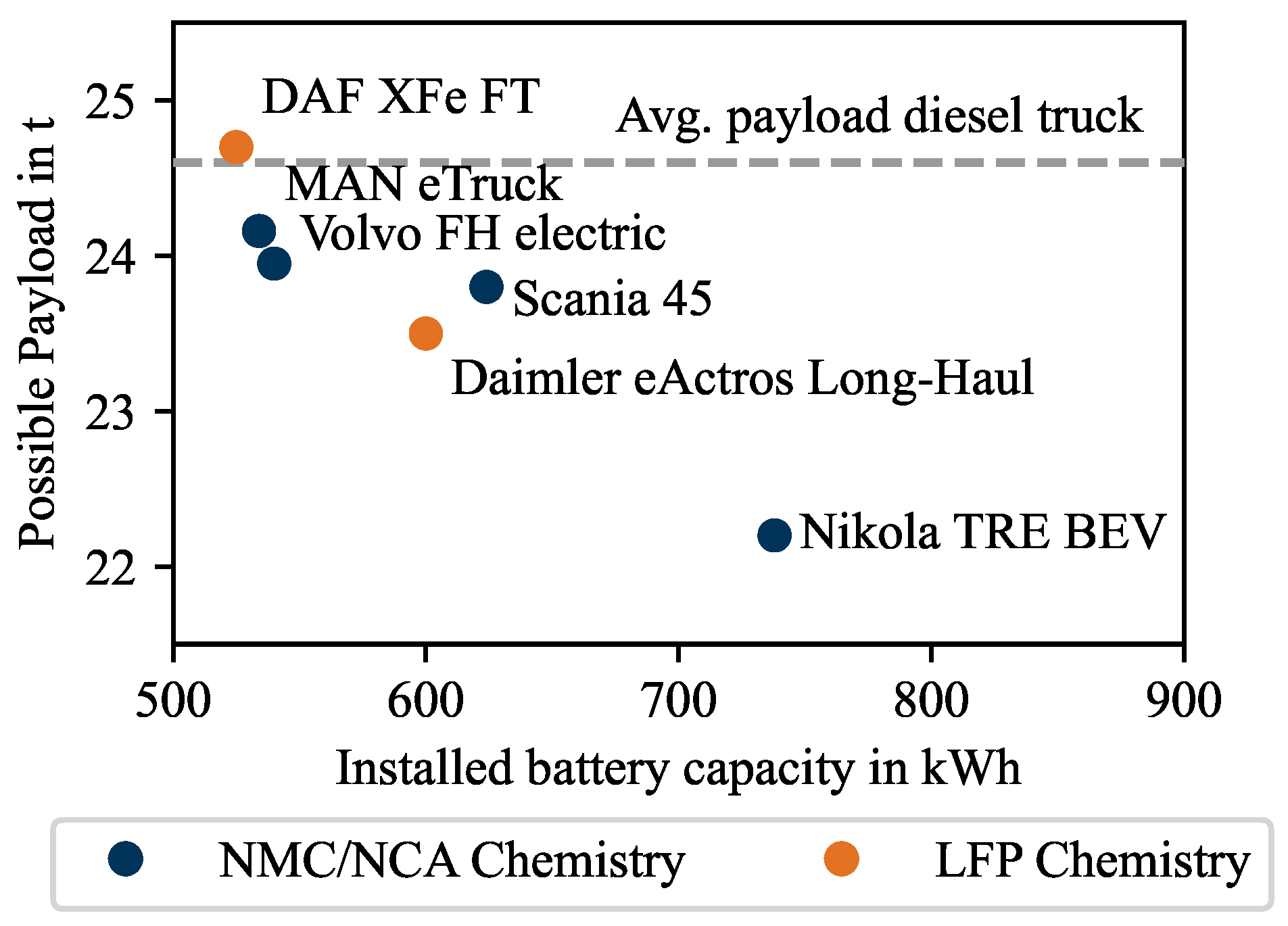
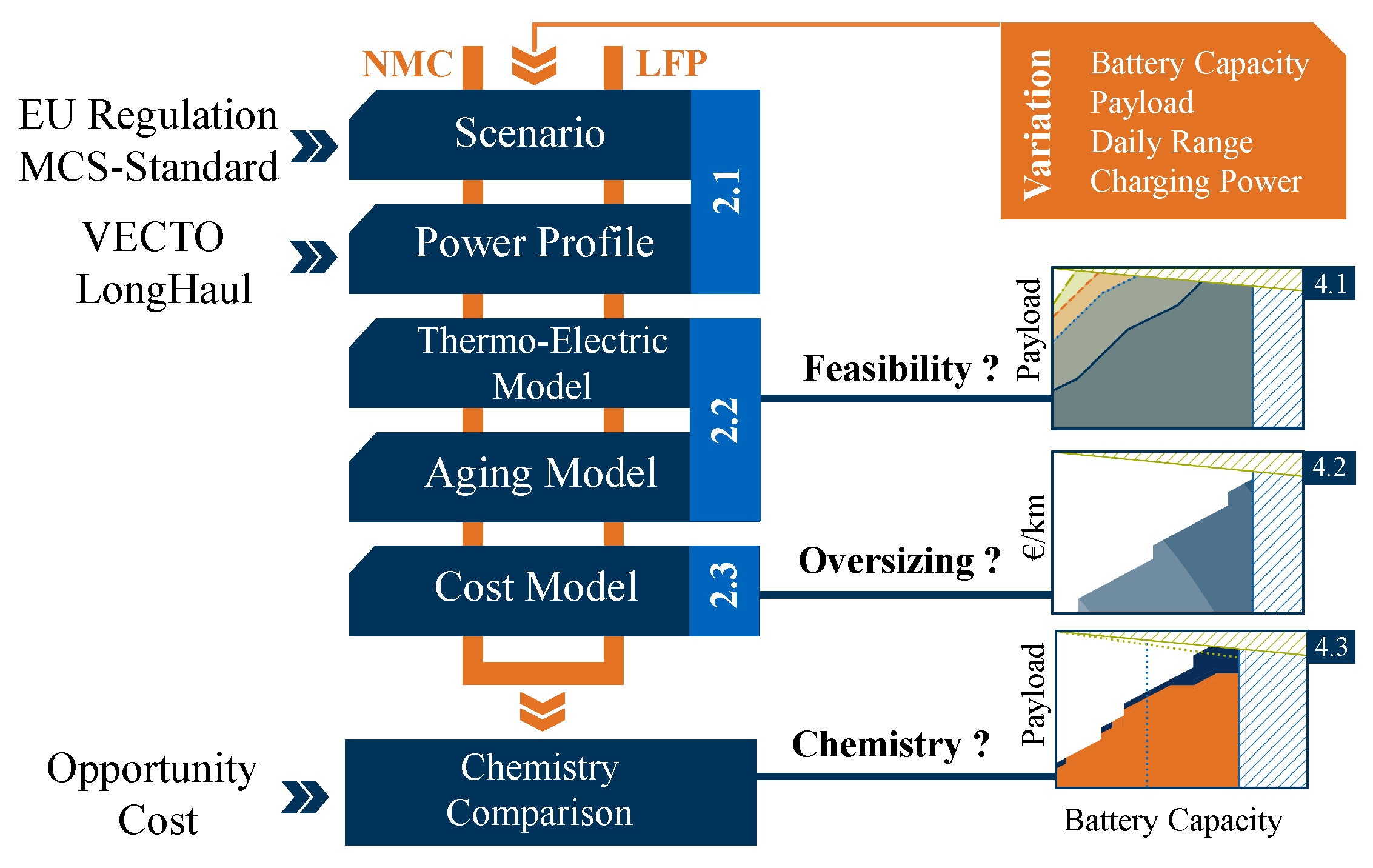
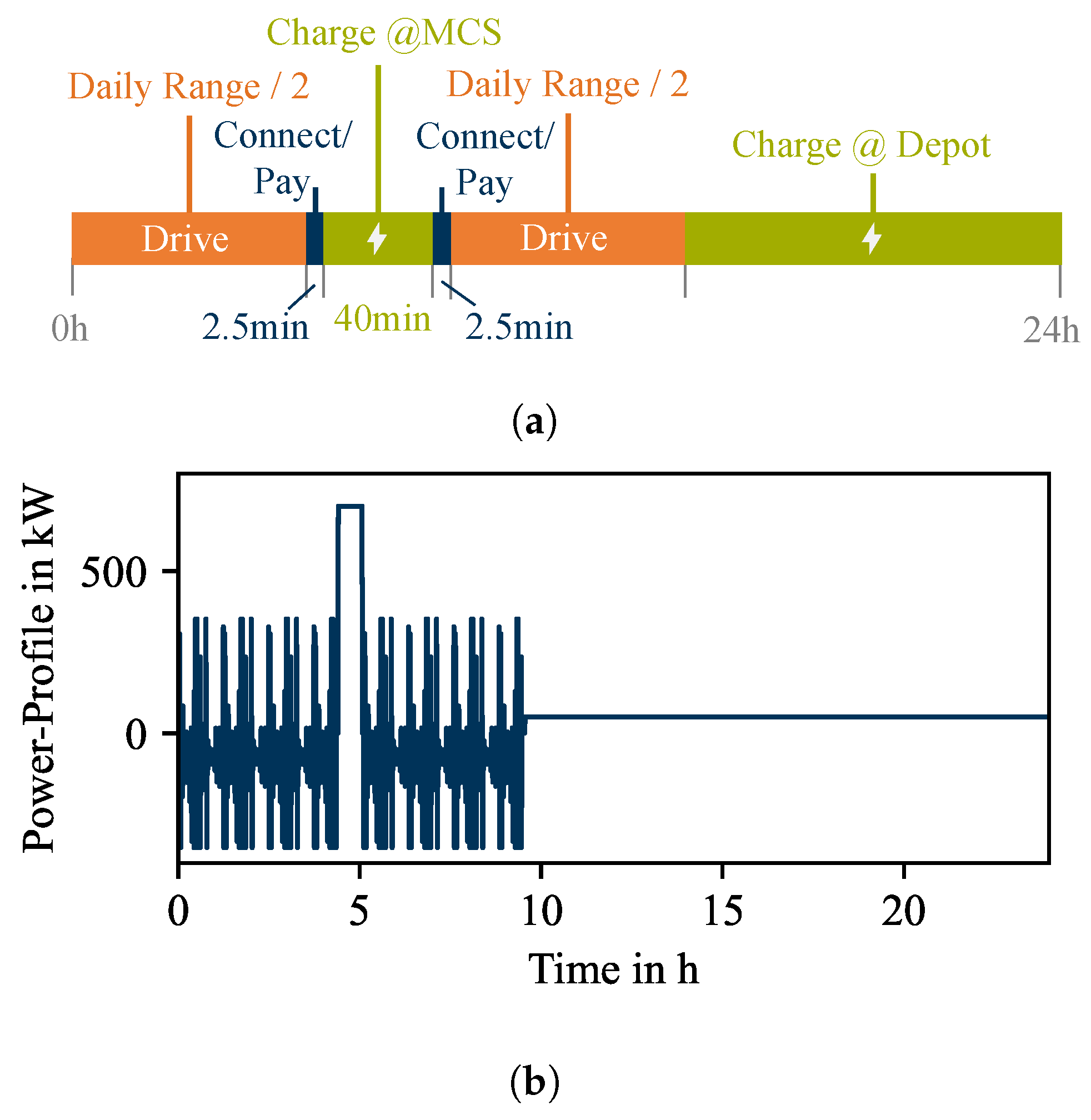
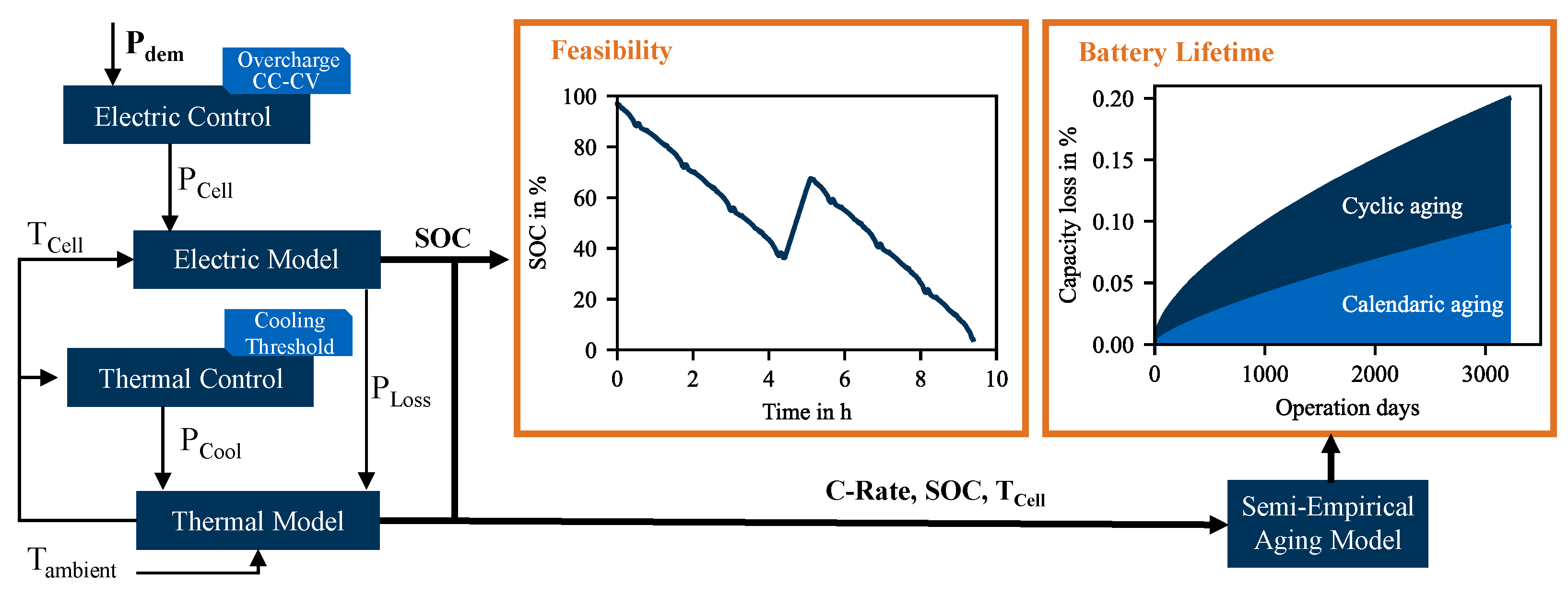

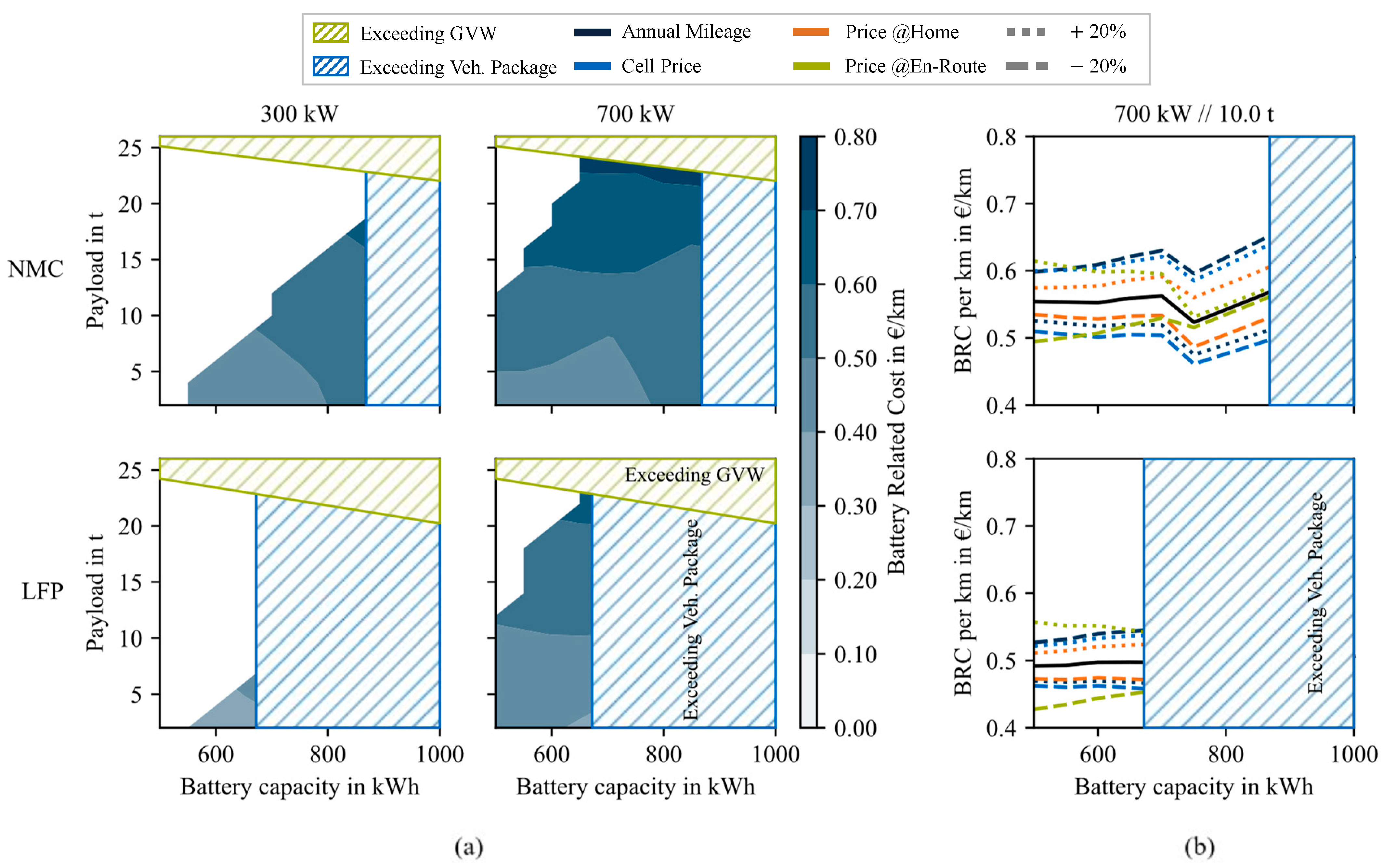
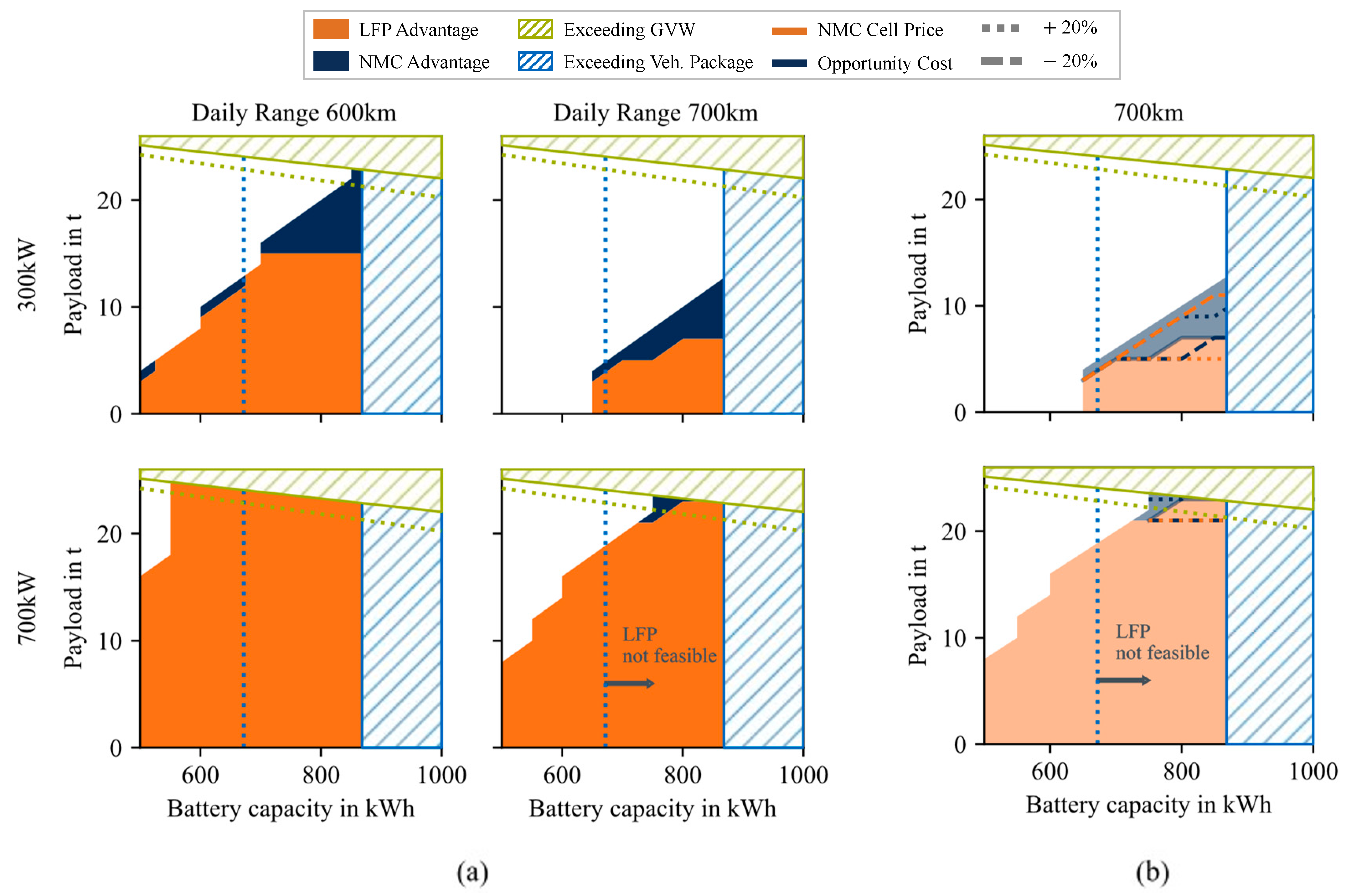
| Section | Parameter | Value | Source |
|---|---|---|---|
| Power Profile | [4] | ||
| [4] | |||
| [15] | |||
| 13,765 kg | [19] | ||
| Thermal/Aging | [37] | ||
| [37] | |||
| 896 | [38] | ||
| 10 | [39] | ||
| [39] | |||
| 33 | [30] | ||
| [30] | |||
| [30] | |||
| [30] | |||
| Feasibility | 42 | [16] | |
| 3250 | [15] | ||
| 5% | |||
| 273 | [30] | ||
| 176 | [19] | ||
| [30] | |||
| [19] | |||
| 685 | [30] | ||
| 376 | [19] | ||
| [30] | |||
| [19] | |||
| 1 | |||
| Cost Model | 140 | [23] | |
| 100 | [23] | ||
| [40] | |||
| 15% | [15] | ||
| 8 | [13] | ||
| 130,000 km | [41] | ||
| [15] | |||
| [42] | |||
| [43] | |||
| r | [15] |
Disclaimer/Publisher’s Note: The statements, opinions and data contained in all publications are solely those of the individual author(s) and contributor(s) and not of MDPI and/or the editor(s). MDPI and/or the editor(s) disclaim responsibility for any injury to people or property resulting from any ideas, methods, instructions or products referred to in the content. |
© 2023 by the authors. Licensee MDPI, Basel, Switzerland. This article is an open access article distributed under the terms and conditions of the Creative Commons Attribution (CC BY) license (https://creativecommons.org/licenses/by/4.0/).
Share and Cite
Schneider, J.; Teichert, O.; Zähringer, M.; Götz, K.; Lienkamp, M. Spoilt for Choice: User-Centric Choice of Battery Size and Chemistry for Battery-Electric Long-Haul Trucks. Energies 2024, 17, 158. https://doi.org/10.3390/en17010158
Schneider J, Teichert O, Zähringer M, Götz K, Lienkamp M. Spoilt for Choice: User-Centric Choice of Battery Size and Chemistry for Battery-Electric Long-Haul Trucks. Energies. 2024; 17(1):158. https://doi.org/10.3390/en17010158
Chicago/Turabian StyleSchneider, Jakob, Olaf Teichert, Maximilian Zähringer, Korbinian Götz, and Markus Lienkamp. 2024. "Spoilt for Choice: User-Centric Choice of Battery Size and Chemistry for Battery-Electric Long-Haul Trucks" Energies 17, no. 1: 158. https://doi.org/10.3390/en17010158






